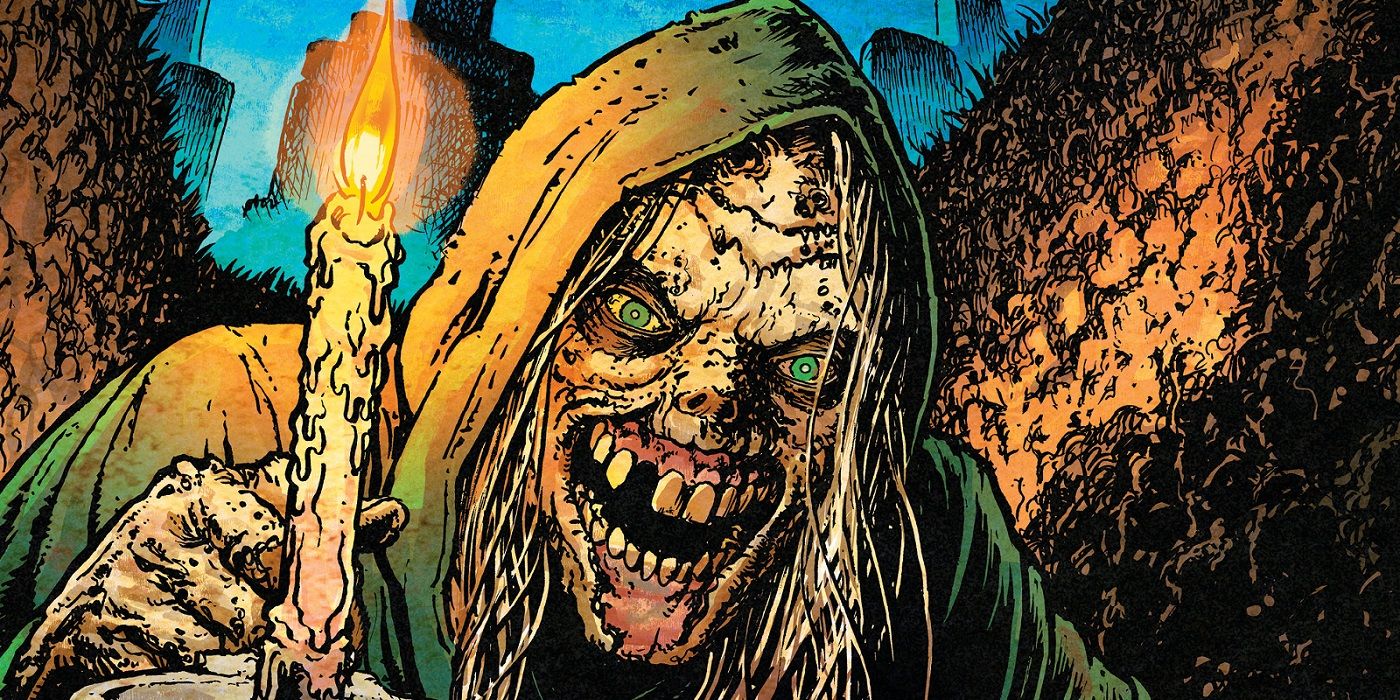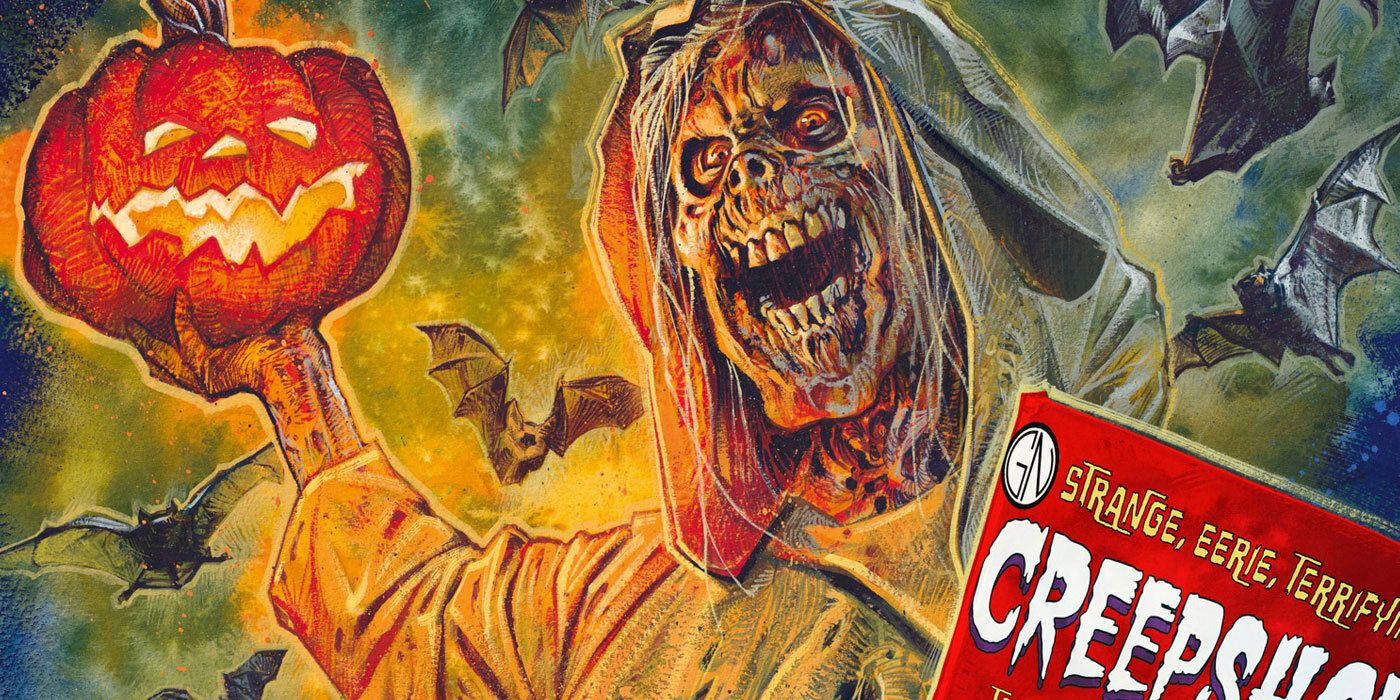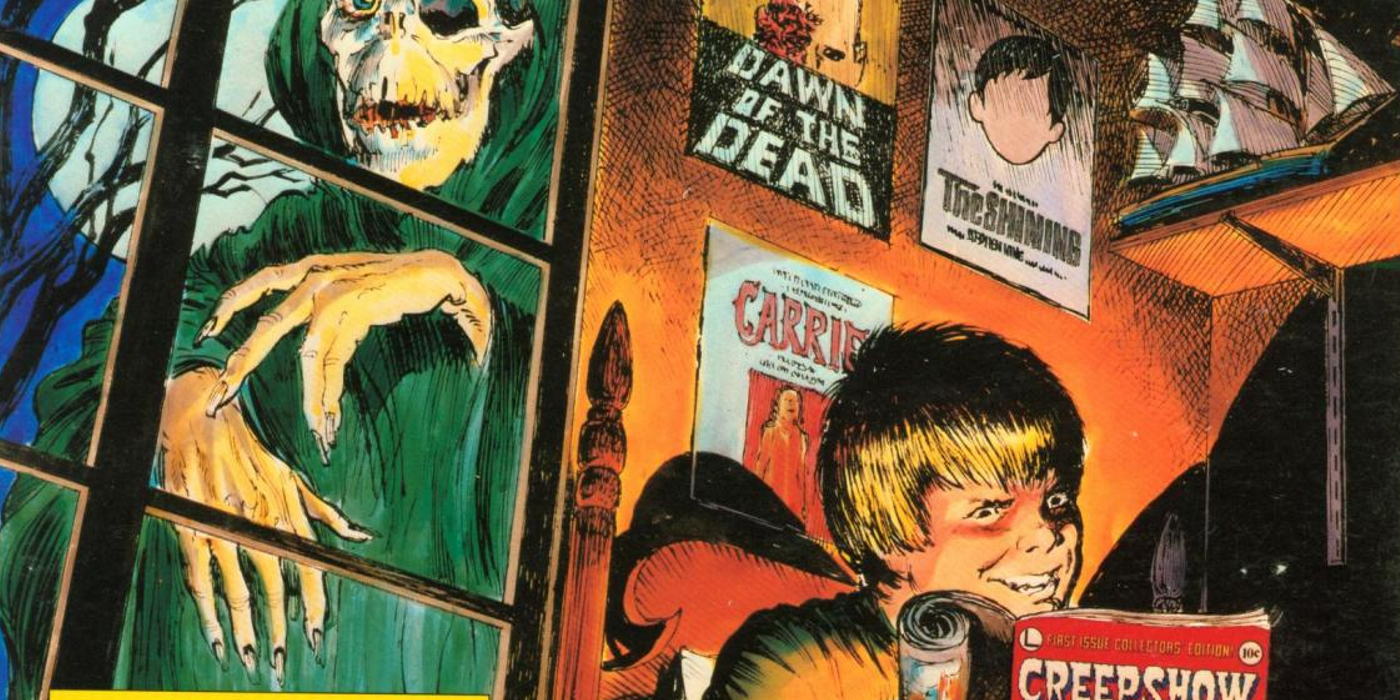The following contains major spoilers for Creepshow #1, available now from Skybound Entertainment.
For many children, Halloween is a day to experience fear while avoiding the sharp claws of true horror. They mock the dead with spooky stories, gorging candy in darkened living rooms while scary movies cast their shadows against the walls. It's a time to escape the fear of death while reveling in the suspense and sensationalism that horror provides. Creepshow #1 (by Chris Burnham, Paul Dini, Steve Langford, and John McCrea) captures the childhood wonder of Halloween perfectly, portraying a world where children tempt death and find themselves cowering from its ghastly glare. The comic forces its young protagonists to tip-toe through a world where Halloween loses its fictional form and mutates into something much more terrifying.
To ease this tension, the comic pulls from the campy and nostalgic roots of 1982's Creepshow anthology comic (by Stephen King, Bernie Wrightson with Michele Wrightson). King's anthology epitomized '80s horror, blending humor, gore, and interpersonal conflict to serve up five short stories that provide the foundation for Creepshow #1. With Halloween fast approaching, let's analyze how Creepshow #1 resurrects the spirit of King's stories to create the perfect comic for the spooky season.
Halloween-themed comics need a creepy storyteller, and Creepshow delivers that by introducing a rotting corpse named The Creep to narrate each tale. The Creep revels in the violent demise of his subjects, cackling at their pain and cheering their gory endeavors with glee. Similar to The Crypt Keeper from Tales From the Crypt, The Creep adds his tongue-in-cheek commentary throughout the issue. His presence infuses the anthology with sick, demented humor that lightens the mood, providing a much-needed palate cleanser amidst the excessive, and often humorous, gore. From clever wordplay to bonafide dad jokes, The Creep demonstrates how twisted humor can add levity and fun to Halloween comics.
1982's Creepshow provides a tantalizing template for how to create a spine-tingling horror comic. "Father's Day," the first entry in the original comic anthology, centers around Great Aunt Bedelia and her mysterious past, a past doused in the blood of her slain father, Nathan. Before meeting her family for dinner, Bedelia visits her father's grave with a bottle of whiskey and digs up the ghosts from her past. She remembers how her father shot her fiancé in the chest and his unceasing demand for cake on Father's Day. She also replays the memory of when, fed-up and fueled by rage, she bashed her father's skull, christening his special day with blood.
Suddenly, Nathan's corpse climbs out of his grave to choke Bedelia, demanding, as he did years before, that he wants his cake. After Nathan crushes Bedielia's body with his gravestone, the vengeful corpse sneaks into the family manor in search of dessert. He murders Sylvia, his daughter's favorite niece, by snapping her neck, and with the party spoiled, serves the guests a corpse-cake complete with candles adorned atop Sylvia's severed head. The final scene reveals the spooky synergy between horror and humor. From the wax candles that drip onto Sylvia's skull to Nathan's excitement after finally getting his cake, 1982's Creepshow proves that Halloween comics can be fun and frightening.
Unlike its predecessor, Creepshow #1's short stories revolve around the terrors that tear youthful innocence limb for limb. "Take One", the issue's first tale, displays the deadly consequences of sugar-lust as it follows Phil, the runt of the group, and his friends' mad dash to steal candy on Halloween. Fate leads the squad to Mr. Xander's abandoned house where a bowl of oversized candy bars mysteriously rests on the dead man's porch, complete with a makeshift sign that reads 'Take One.' Rumor has it that Xander's daughter split his skull in half, but the gang ignores the old man's warning, stealing all the candy bars as they flee the scene. It doesn't take a master sleuth to predict what happens next. Xander's corpse finds the squad of sinners and executes them one by one.
While 1982's Creepshow was chock-full of gore, this modern revival cranks up the death scenes. Xander curb-stomps a teen's skull into a sewer grate, dislodging the young man's eyeballs. Not to be outdone, the vengeful old man rips the intestines out from a boy in a hot dog suit, continuing the sick sense of humor from King's anthology. In a desperate plea for mercy, Phil pukes up his chocolate bar and offers it back to Xander, but it's too late. The final page reveals Phil and his friends, eyeless and toothless with a bowl overflowing with intestines and a sign that reads 'Take One.' Sensationalism is the still-beating heart of Halloween Comics, and "Take One" exaggerates its violence for humorous and horrifying effects.
Creepshow #1 honors the legacy of King's anthology while redefining Halloween comics for a new generation. The issue evokes a violent nostalgia that mirrors another King classic, It, reminding readers that no one -- not even children -- can flee death. With a healthy dose of humor, The Creep guides audiences through the fun of the fear-filled holiday, affirming that Halloween comics, much like the day itself, should celebrate gore, violence, and the humorous moments in between.



